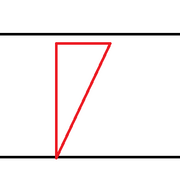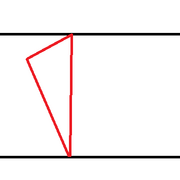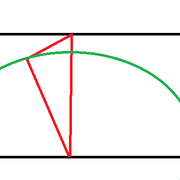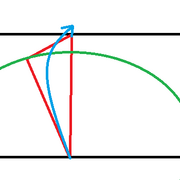Post by Xarious on Oct 17, 2016 23:52:16 GMT -5
So you've probably already looked at Strafing Concepts, which is a decent overview of the majority of the information you actually really need in order to strafe jump. However, we've yet to dive into the more complex elements: How and why does this actually work? That's what this post will be explaining.
Before I begin, shoutout to EFF and their wiki resources for having a very good explanation. If you haven't read it, they probably do a better job than I do here, so go ahead and check it out: eff.wikia.com/wiki/Advanced_jumping
Additional shoutout to this ancient link (had to use Wayback to find it), it has some pretty detailed math about Q3 strafe: web.archive.org/web/20190226193727/http://funender.com/quake/articles/strafing_theory.html
I'll also be borrowing EFF's images to explain this, so really, hardcore credit there. However, I don't fully agree with the way they explained it and therefore I'm writing my own slightly modified version.
So, before I start, I want to preface this by saying this first part isn't necessarily correct. Why do I have it here, then? So that when I reach Part 2 of this post, I can explain where and why this theory is not 100% correct and alter it (hence the entire reason for restating information EFF has effectively already provided).
Why does it work?
Well, from what I gather, a standard jump works something like a right triangle. Yes, those derpy things you learned about in geometry class years ago.

Yea, that thing.
So, your usual jump with just going straight forward (that is, W+Space) is going to follow the line above from the bottom of the black line to the top. Except, as you can see, that gap is too big for you to jump. Thus, you wont make it. So, take a trip back to your highschool class and think: How could we fix this?
If you answered "the hypotenuse of the triangle, which is opposite the right angle, is the longest side and therefore can be turned to make the jump" you are not only correct, you are also now a certifiable nerd. So, lets quickly turn that triangle and see what happens:

Cool. We win, right? Well.. Sort of.
So, we know what we need to do to reach out goal but.. how do we do that? To answer that, you kinda have to take a good look at what we did to reach that point. Instead of jumping with W, you're doing a diagonal jump. You're not jumping with D or A here either, this is sort of an in-between area like WD or WA.
Except, before you go off trying to jump with those in a straight line, that's not going to work either.

And thus, this picture was made.
See, as the EFF wiki so elegantly puts it, "game makers predicted such 'hax' and protected the game from it." So, we're back to square one. You can't even jump diagonal and succeed. Case closed, right?
Wrong.
Despite their efforts, we can still trick the game into allowing this. The way we do this is simple: We use the mouse to curve the jump, so that it registers as what would otherwise be diagonal, while still technically travelling straight. This allows us to travel in that hypotenuse line, and successfully navigate ourselves to the other side.

Basically, that blue line there.
The easiest way to judge this, is to start your jump facing about 90 degrees away from your target, and turn toward it as you get closer. When doing air-based strafing, you always want to be using WD or WA. While the physical turning of the mouse is the most important element, you wont get nearly as much out of it unless you pair it with the diagonal key press. There are programs, such as strafehelper, that will aid you in achieving the optimal turns for getting the most distance out of your strafe. If you're interested in genuinely improving at it, strafehelper is highly endorsed for training purposes.
Now, about that alteration to the original text... Please keep in mind, this is a big alteration. The text prior is only half-correct as a result.
As it would just so happen, there is a concept called W Key Strafing. This is, effectively, utilizing the engine's mouse curve process to produce these same results without ever using A or D. While this form of strafing is incapable of producing results that are as good as utilizing the A and D keys, it serves to prove that the mouse curving process is not only completely independent of strafe keys, but is also, by far, the most essential element of speed. In fact, this amendment to the initial post is a big one for setting the record straight: A and D are almost only necessary as directional guides. Without them, you are unable to guide yourself properly because the amount of extra curve required to produce the same results will put you entirely off track.
However, this "W Key Strafing" statement can be a bit misleading. Indeed, this applies to any Single-Key Strafing (only A, only D, only W). Allow me to further explain...
As can be seen from the movement speeds testing section of the database, W, A, and D all carry identical speed on the ground. Indeed, if one were to jump with strictly A + space or D + space, it would produce an identical result to W + space. Now, the prior information is still all correct, but there is a strange stipulation on diagonal motions. The action of changing motion from strictly W or strictly A or strictly D to either W+A or W+D creates a short but sudden boost to speed. This can cap at approximately 293ups. Prior to the switch, you will be traveling at the standard 250ups. After the switch, you will return to 250ups. This is a very short window of opportunity. When you jump while pressing WD or WA, your jump will take the speed you are at during the very moment of jumping, and maintain that speed. This means that you can get anywhere between 250 and 293ups solely from jumping immediately after adding a second key to the mix.
In short, adding the extra key gives a very brief window of increased speed that can be added to the jump. It essentially acts as its own form of a circle jump. This means that at no time do you actually require the A or D keys to get the maximum potential of the physical jump. Instead, they are simply required to boost your speed and give you higher distance potential. This is a direct result of the game also compensating for diagonal movements in the same way it compensates for A and D movements on the triangle, however it fails to compensate for the first few moments of the motion. After that, any jump you make with a diagonal movement (WA, WD) will only receive the same speed as A, W, or D alone (250ups).
Here is a short video example of Art utilizing her single-key strafe with W:
So... I should always do this?
No. If you're looking to move fast on the ground and across the map, there are better ways of doing that. These ways would be strafe hopping.
Hops are done without using force, and using this same principle on a smaller scale. There are a few ways you can do this, and I'll be covering them here. Each has their own preferred angles to be moving in (that will be easier to see in the video below) and, once again, it is advisable to use Strafe Helper for learning angle motions.
Single Beat
This is pretty simple, and pretty standard. All you have to do is hold forward (W) and switch between A and D as you strafe. So, you're effectively going to do WA-WD-WA-WD. This form of strafing grants quick acceleration.
Double Beat
Again, a fairly standard way to strafe. Only, in this case, you're repeating the same one twice in a row, essentially doing WA-WA-WD-WD-WA-WA. This form of strafing emphasizes control over movement.
Half Beat
This is kind of your 50/50. Half beats (otherwise known as hybrids) are mixing WD and WA with pure A and D movement. So, either WA-D-WA-D or WD-A-WD-A style motions.
Inverted
This is your full A-D style movement. While you still need to begin strafing with WD or WA to gain initial acceleration, you can simply use A-D-A-D after that to keep in motion. This is a perfect example of single-key strafe in the format of speed strafing, and gives way to the fact that WA/WD are required for the initial jump to boost speed.
Circle Jumping
So, for anyone who already read my Strafing Concepts post, I gave a pretty decent explanation, but I didn't detail the exact reasons it works. As you can see from my Movement Speeds post in the technical knowledge area, average movement is ~250ups with W, A, and D. However, when you're moving in a circle motion on the ground and curving your mouse, you can cap out at ~310ups. Circle Jumping is the art of capping your initial jump as fast as you can, so that when you jump off with WA or WD, you can max your acceleration potential. Do note that, although I mentioned you can use A and D to jump off from a circle jump, you will effectively lose out on speed because WA and WD are the fastest accelerator movements in the game.
That's all for now! Questions & comments welcome as usual!
Before I begin, shoutout to EFF and their wiki resources for having a very good explanation. If you haven't read it, they probably do a better job than I do here, so go ahead and check it out: eff.wikia.com/wiki/Advanced_jumping
Additional shoutout to this ancient link (had to use Wayback to find it), it has some pretty detailed math about Q3 strafe: web.archive.org/web/20190226193727/http://funender.com/quake/articles/strafing_theory.html
I'll also be borrowing EFF's images to explain this, so really, hardcore credit there. However, I don't fully agree with the way they explained it and therefore I'm writing my own slightly modified version.
So, before I start, I want to preface this by saying this first part isn't necessarily correct. Why do I have it here, then? So that when I reach Part 2 of this post, I can explain where and why this theory is not 100% correct and alter it (hence the entire reason for restating information EFF has effectively already provided).
Why does it work?
Well, from what I gather, a standard jump works something like a right triangle. Yes, those derpy things you learned about in geometry class years ago.

Yea, that thing.
So, your usual jump with just going straight forward (that is, W+Space) is going to follow the line above from the bottom of the black line to the top. Except, as you can see, that gap is too big for you to jump. Thus, you wont make it. So, take a trip back to your highschool class and think: How could we fix this?
If you answered "the hypotenuse of the triangle, which is opposite the right angle, is the longest side and therefore can be turned to make the jump" you are not only correct, you are also now a certifiable nerd. So, lets quickly turn that triangle and see what happens:

Cool. We win, right? Well.. Sort of.
So, we know what we need to do to reach out goal but.. how do we do that? To answer that, you kinda have to take a good look at what we did to reach that point. Instead of jumping with W, you're doing a diagonal jump. You're not jumping with D or A here either, this is sort of an in-between area like WD or WA.
Except, before you go off trying to jump with those in a straight line, that's not going to work either.

And thus, this picture was made.
See, as the EFF wiki so elegantly puts it, "game makers predicted such 'hax' and protected the game from it." So, we're back to square one. You can't even jump diagonal and succeed. Case closed, right?
Wrong.
Despite their efforts, we can still trick the game into allowing this. The way we do this is simple: We use the mouse to curve the jump, so that it registers as what would otherwise be diagonal, while still technically travelling straight. This allows us to travel in that hypotenuse line, and successfully navigate ourselves to the other side.

Basically, that blue line there.
The easiest way to judge this, is to start your jump facing about 90 degrees away from your target, and turn toward it as you get closer. When doing air-based strafing, you always want to be using WD or WA. While the physical turning of the mouse is the most important element, you wont get nearly as much out of it unless you pair it with the diagonal key press. There are programs, such as strafehelper, that will aid you in achieving the optimal turns for getting the most distance out of your strafe. If you're interested in genuinely improving at it, strafehelper is highly endorsed for training purposes.
Now, about that alteration to the original text... Please keep in mind, this is a big alteration. The text prior is only half-correct as a result.
As it would just so happen, there is a concept called W Key Strafing. This is, effectively, utilizing the engine's mouse curve process to produce these same results without ever using A or D. While this form of strafing is incapable of producing results that are as good as utilizing the A and D keys, it serves to prove that the mouse curving process is not only completely independent of strafe keys, but is also, by far, the most essential element of speed. In fact, this amendment to the initial post is a big one for setting the record straight: A and D are almost only necessary as directional guides. Without them, you are unable to guide yourself properly because the amount of extra curve required to produce the same results will put you entirely off track.
However, this "W Key Strafing" statement can be a bit misleading. Indeed, this applies to any Single-Key Strafing (only A, only D, only W). Allow me to further explain...
As can be seen from the movement speeds testing section of the database, W, A, and D all carry identical speed on the ground. Indeed, if one were to jump with strictly A + space or D + space, it would produce an identical result to W + space. Now, the prior information is still all correct, but there is a strange stipulation on diagonal motions. The action of changing motion from strictly W or strictly A or strictly D to either W+A or W+D creates a short but sudden boost to speed. This can cap at approximately 293ups. Prior to the switch, you will be traveling at the standard 250ups. After the switch, you will return to 250ups. This is a very short window of opportunity. When you jump while pressing WD or WA, your jump will take the speed you are at during the very moment of jumping, and maintain that speed. This means that you can get anywhere between 250 and 293ups solely from jumping immediately after adding a second key to the mix.
In short, adding the extra key gives a very brief window of increased speed that can be added to the jump. It essentially acts as its own form of a circle jump. This means that at no time do you actually require the A or D keys to get the maximum potential of the physical jump. Instead, they are simply required to boost your speed and give you higher distance potential. This is a direct result of the game also compensating for diagonal movements in the same way it compensates for A and D movements on the triangle, however it fails to compensate for the first few moments of the motion. After that, any jump you make with a diagonal movement (WA, WD) will only receive the same speed as A, W, or D alone (250ups).
Here is a short video example of Art utilizing her single-key strafe with W:
So... I should always do this?
No. If you're looking to move fast on the ground and across the map, there are better ways of doing that. These ways would be strafe hopping.
Hops are done without using force, and using this same principle on a smaller scale. There are a few ways you can do this, and I'll be covering them here. Each has their own preferred angles to be moving in (that will be easier to see in the video below) and, once again, it is advisable to use Strafe Helper for learning angle motions.
Single Beat
This is pretty simple, and pretty standard. All you have to do is hold forward (W) and switch between A and D as you strafe. So, you're effectively going to do WA-WD-WA-WD. This form of strafing grants quick acceleration.
Double Beat
Again, a fairly standard way to strafe. Only, in this case, you're repeating the same one twice in a row, essentially doing WA-WA-WD-WD-WA-WA. This form of strafing emphasizes control over movement.
Half Beat
This is kind of your 50/50. Half beats (otherwise known as hybrids) are mixing WD and WA with pure A and D movement. So, either WA-D-WA-D or WD-A-WD-A style motions.
Inverted
This is your full A-D style movement. While you still need to begin strafing with WD or WA to gain initial acceleration, you can simply use A-D-A-D after that to keep in motion. This is a perfect example of single-key strafe in the format of speed strafing, and gives way to the fact that WA/WD are required for the initial jump to boost speed.
Circle Jumping
So, for anyone who already read my Strafing Concepts post, I gave a pretty decent explanation, but I didn't detail the exact reasons it works. As you can see from my Movement Speeds post in the technical knowledge area, average movement is ~250ups with W, A, and D. However, when you're moving in a circle motion on the ground and curving your mouse, you can cap out at ~310ups. Circle Jumping is the art of capping your initial jump as fast as you can, so that when you jump off with WA or WD, you can max your acceleration potential. Do note that, although I mentioned you can use A and D to jump off from a circle jump, you will effectively lose out on speed because WA and WD are the fastest accelerator movements in the game.
That's all for now! Questions & comments welcome as usual!